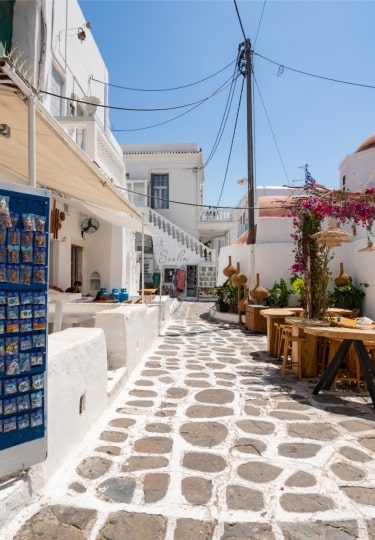While Mykonos has several settlements, buzzy Old Town Mykonos, or Chora, as the locals know it, is the place to hang out to get the best from the island. Set in the heart of the Aegean Sea’s Cyclades group, Mykonos came to fame in the 1950s as a hideaway, first for hippies and artsy types, before becoming the preserve of celebrities.
Its Old Town is set around an old fishing harbor, taking in the ferry port as well as iconic Little Venice and the equally impressive seven Venetian-era windmills that overlook the port.
Mykonos Old Town features a maze of back streets lined with some of the best shopping, restaurants, bars, and clubbing in the Aegean, while its legendary party beaches are just a short water taxi jaunt away.
Attractions in Old Town Mykonos
Little Venice
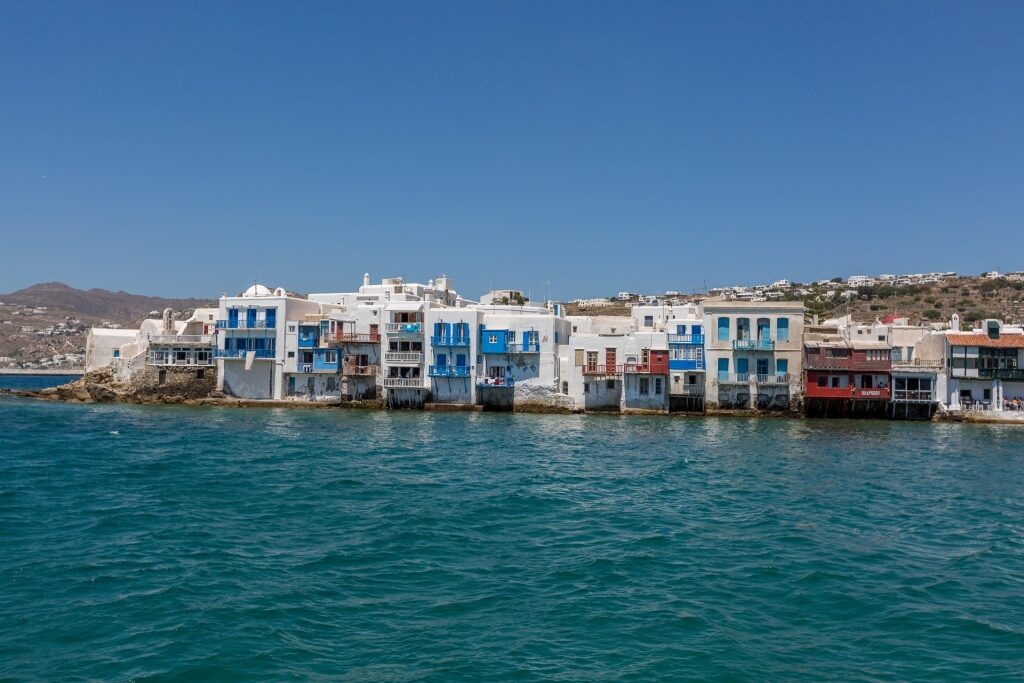
Little Venice
Many of the Greek islands have remnants of Venetian-era rule, broadly from the 12th to 18th centuries, but in many case, it is in the form of a crumbling castle or falling fortifications. Not so here where Little Venice is probably the main draw in Old Town Mykonos.
Here, houses cling to the water’s edge, their colorful wooden balconies hanging precariously over the sea below.
A small maze of streets on the “land side” makes up this most romantic of neighborhoods with its chic cafés, traditional tavernas, and stylish bars. As one of the most beautiful places in Greece, it’s an ideal spot to while away a few hours and drink in the Old Town’s buzzy atmosphere.
Windmills of Mykonos
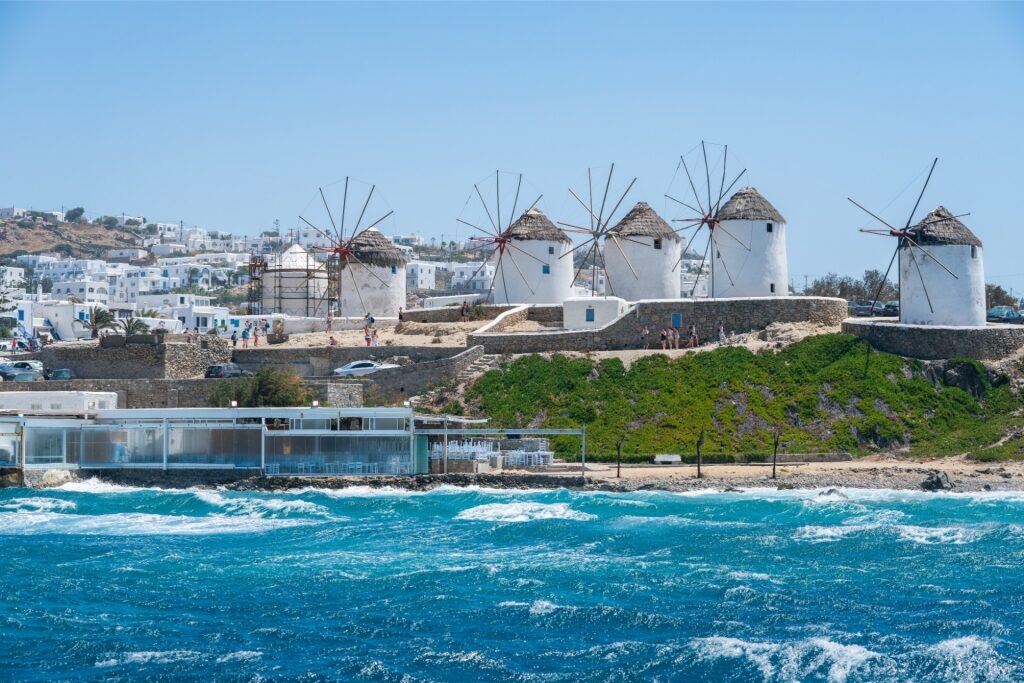
Windmills of Mykonos
Another icon in Mykonos Old Town is these seven windmills, also from the Venetian era, that have graced many a postcard and magazine cover.
Formerly used to grind wheat, and mainly facing north to take advantage of the prevailing winds, they sit on a small hill overlooking the town with their white-washed walls resplendent in the sun.
Most of them are now restored as homes or storage spaces and a photo here is the very least you should take home from a Mykonos visit.
Church of Panagia Paraportiani
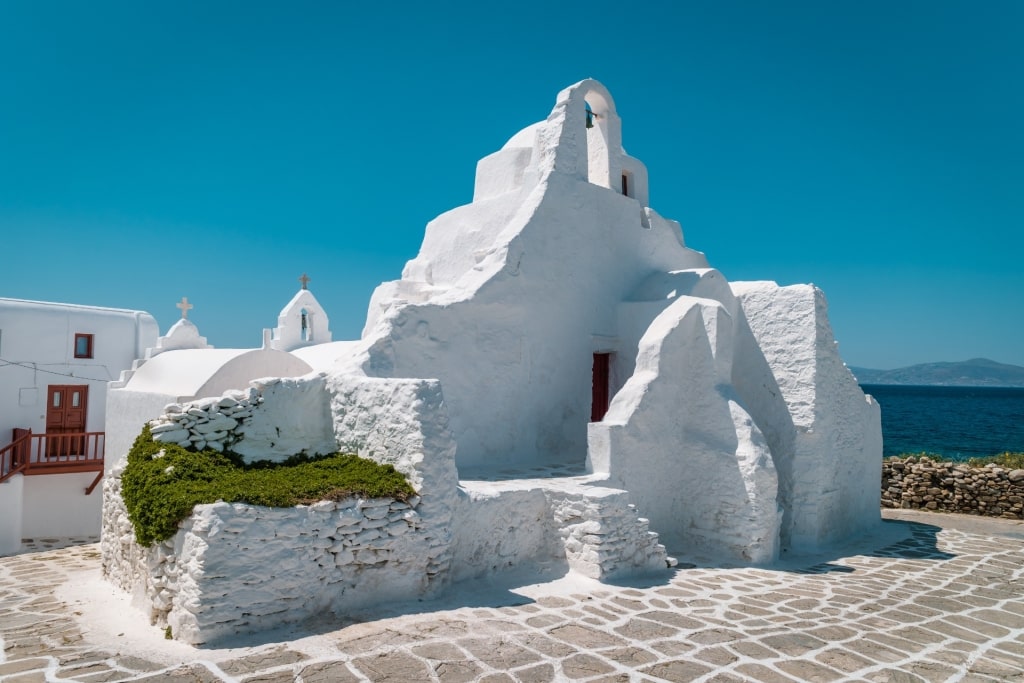
Church of Panagia Paraportiani
The Church of Panagia Paraportiani in Mykonos Old Town is said to be one of Greece’s most photographed churches. This Greek landmark sits on the edge of the Kastro neighborhood that takes in what is left of the Venetian-era castle, and the name Paraportiani means “standing by the door” as it once guarded one of the castle gates.
Contrary to what many think, there are actually five churches here all joined together and built between the 15th and 17th centuries.
Mykonos Town Hall
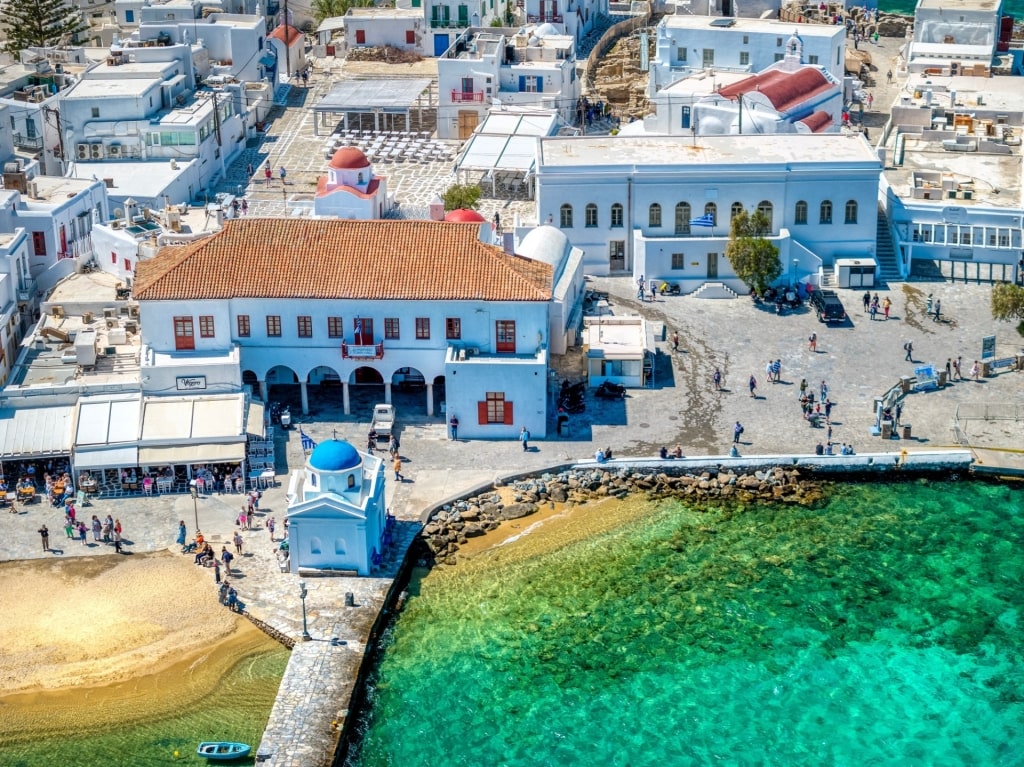
Mykonos Town Hall
One of the dominating buildings in Old Town Mykonos, the town hall overlooks the harbor from a small peninsula on which Panagia Paraporiani sits on the opposite site.
A neoclassical two-story building with a tiled roof, it was built in 1785 to accommodate the Russian count Ivan Voinovich—the General of the Archipelago—during the Russo-Turkish War. Today it houses six libraries with many books about the island, the office of the mayor of Mykonos, and other civic offices.
Matogianni Street
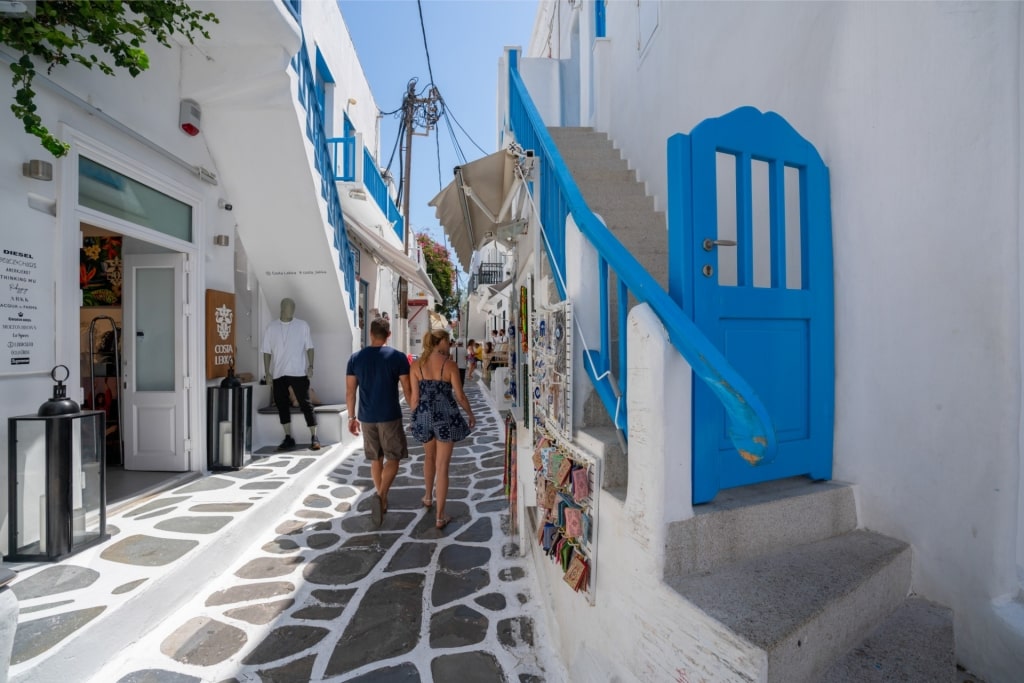
Matogianni Street
Close to Little Venice and the Aegean Maritime Museum, Matogianni Street is a central, mainly pedestrianized thoroughfare in Mykonos Old Town.
A cobbled street with white-washed buildings and splashes of color provided by blue or brown shutters and tumbling scarlet bougainvillea flowers, it’s home to high-end shops and restaurants, as well as a constant hum of activity, no matter what time you visit.
Aegean Maritime Museum
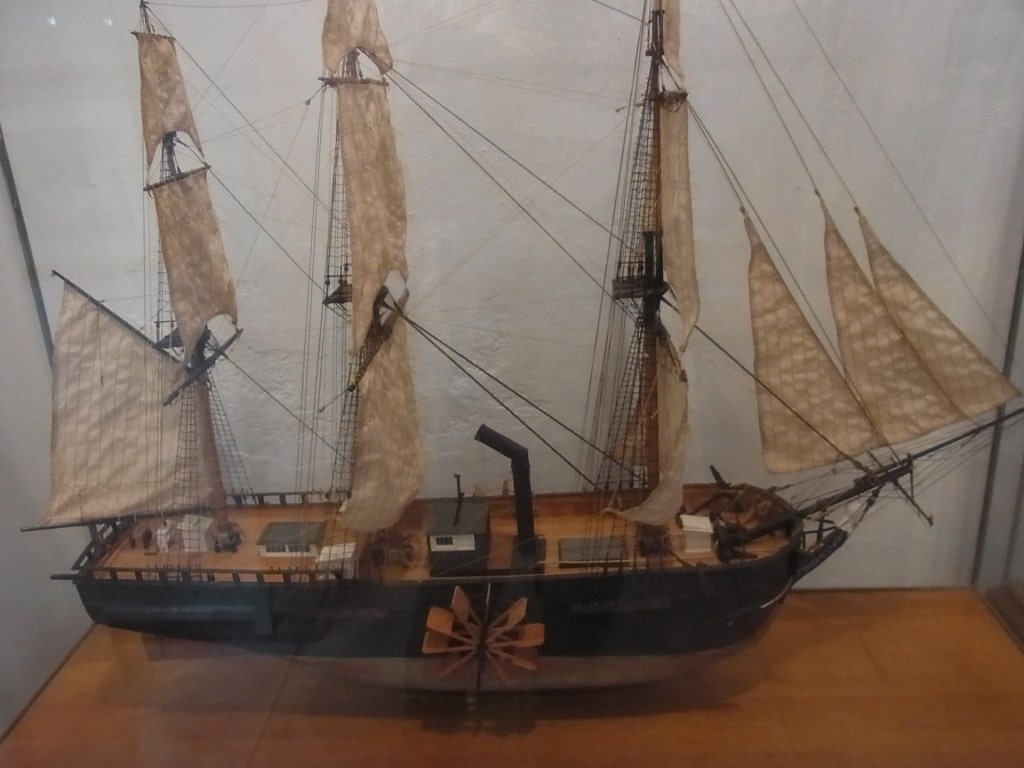
Aegean Maritime Museum Photo by Iantomferry on Wikimedia Commons, licensed under CC BY 3.0
Set in what was the elegant home of merchant captain Nikolaos Sourmelis—a hero of the Cretan War of Independence—the Aegean Maritime Museum in Old Town Mykonos offers a deep dive into Greece’s maritime history.
Founded by George M. Dracopoulos, it includes models of ships from the pre-Minoan period to today, historical shipping documents, engravings, maps, race coins, and other artifacts. It is only open through the main tourist season, from April to October, and hours can be erratic, so calling ahead is advised.
Lena’s House Folk Museum
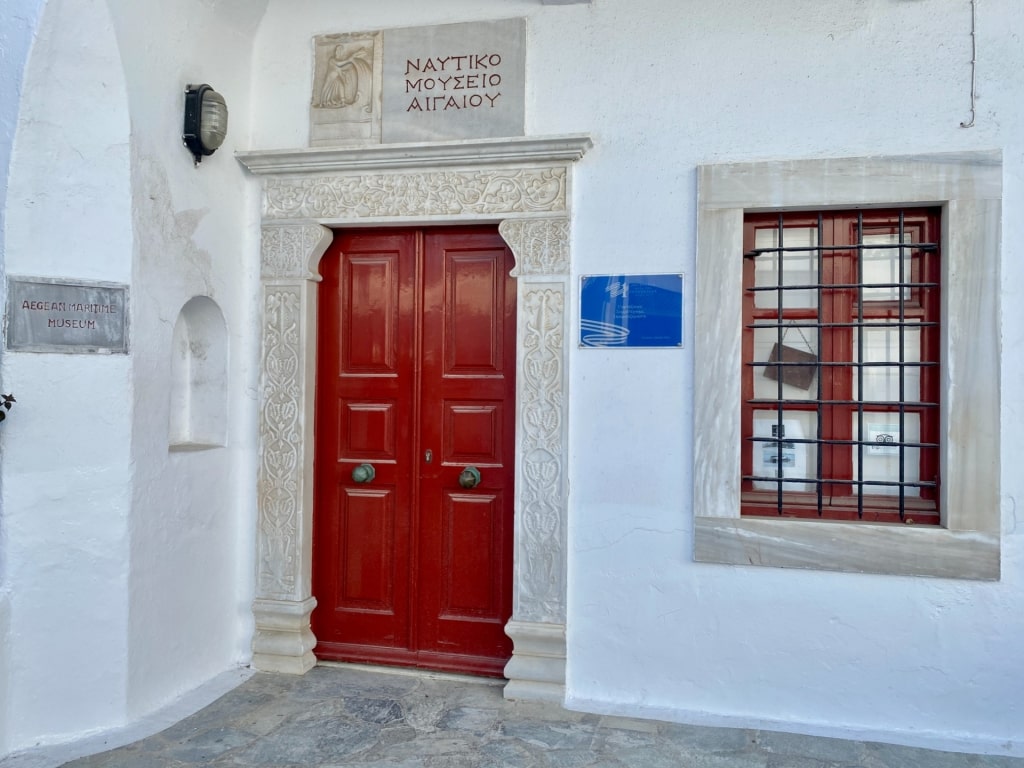
Lena’s House Folk Museum Photo by Warren LeMay on Flickr, licensed under CC BY-SA 2.0
The Folklore Collection of Mykonos is a museum that delves deep into local lore over three different buildings. Founded in 1958, it includes the Kastro House, which is home to the main body of the collection, an agricultural museum housed in a 16th-century windmill, and lovely Lena’s House in the Old Town.
The 19th-century townhouse was donated to the collection in 1970 and contains period furniture and other items owned by its last inhabitant, Lena Skrivanou.
Manto Mavrogenous Square
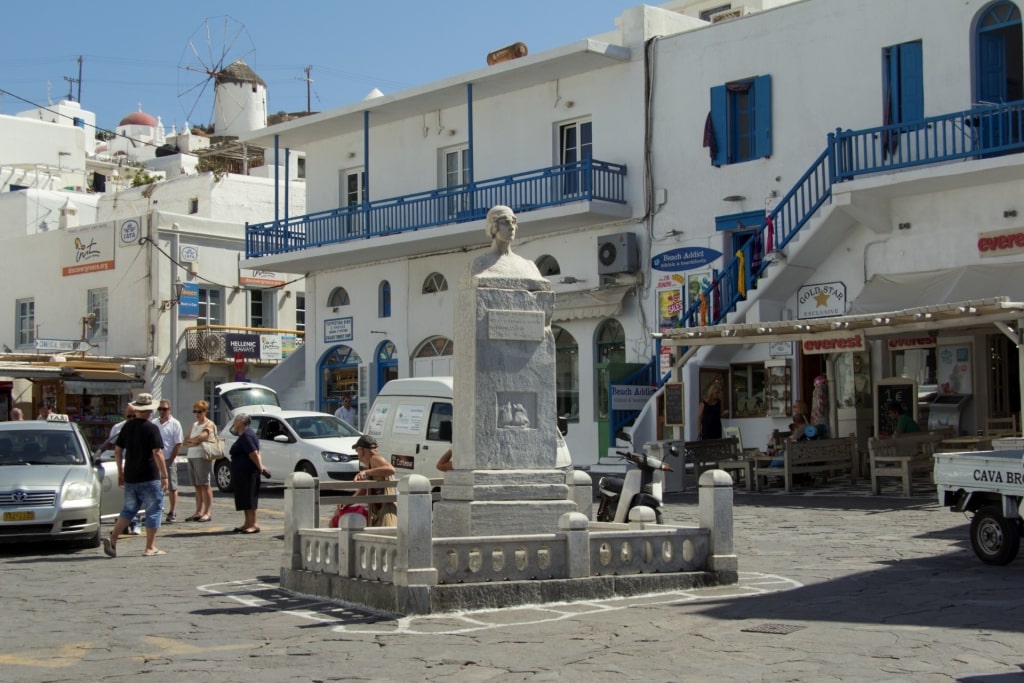
Manto Mavrogenous Square Photo by Zde on Wikimedia Commons, licensed under CC BY-SA 4.0
When it comes to heroines, Magdalena “Manto” Mavrogenous tops the list by far in Mykonos. A beautiful, rich aristocrat, she not only donated all her money to the cause in the 1821 Battle of Independence against Ottoman rule, she was also a military commander who led expeditions against Greece’s Turkish occupiers.
This central square in her honor is as busy as they come and is home to a larger-than-life-size bust of Manto herself.
Things to Do in Old Town Mykonos
Take a Stroll
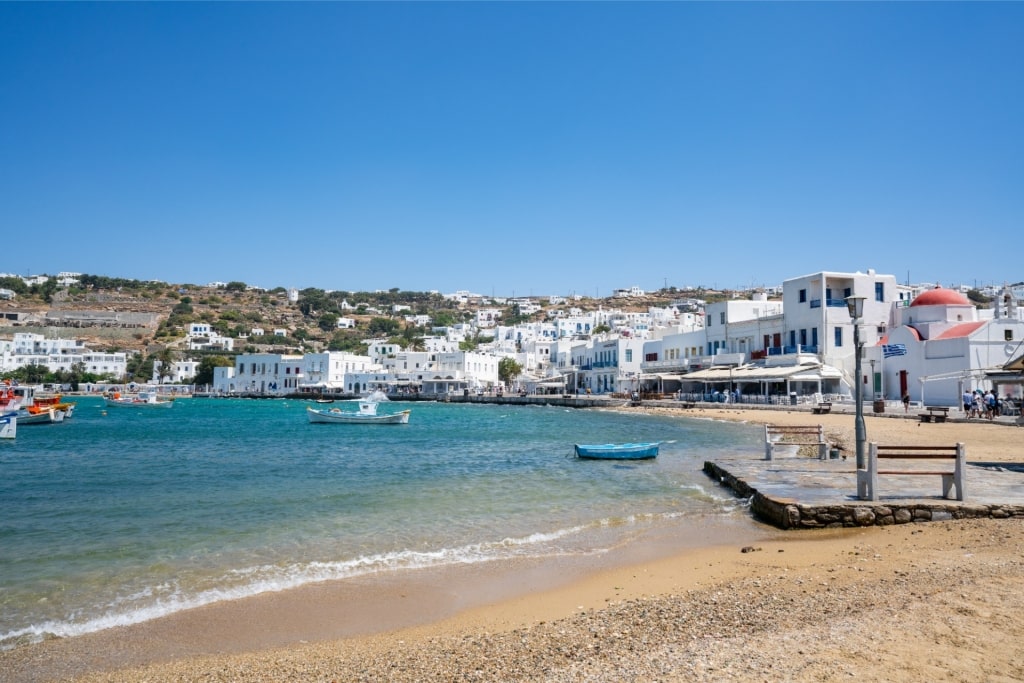
Old Town Mykonos
The best way to get a feel for Mykonos Old Town is, simply, to take a stroll around, enjoy the atmosphere, and see all the main sights, which are in quite a compact area.
Start off to the north of the crescent-shaped harbor and walk south, past the Archaeological Museum and Chora Beach, and enter the Old Town proper at Manto Mavrogenous Square. Look out for Mattheou Andronikou Street which turns into the main Matogianni Street to the south.
Making a right turn at Enoplon Dynameon Street passes by Lena’s House and brings you back to the south end of the harbor, where the windmills, Little Venice, and the Church of Panagia Paraportiani can be found.
Shop ‘Till You Drop
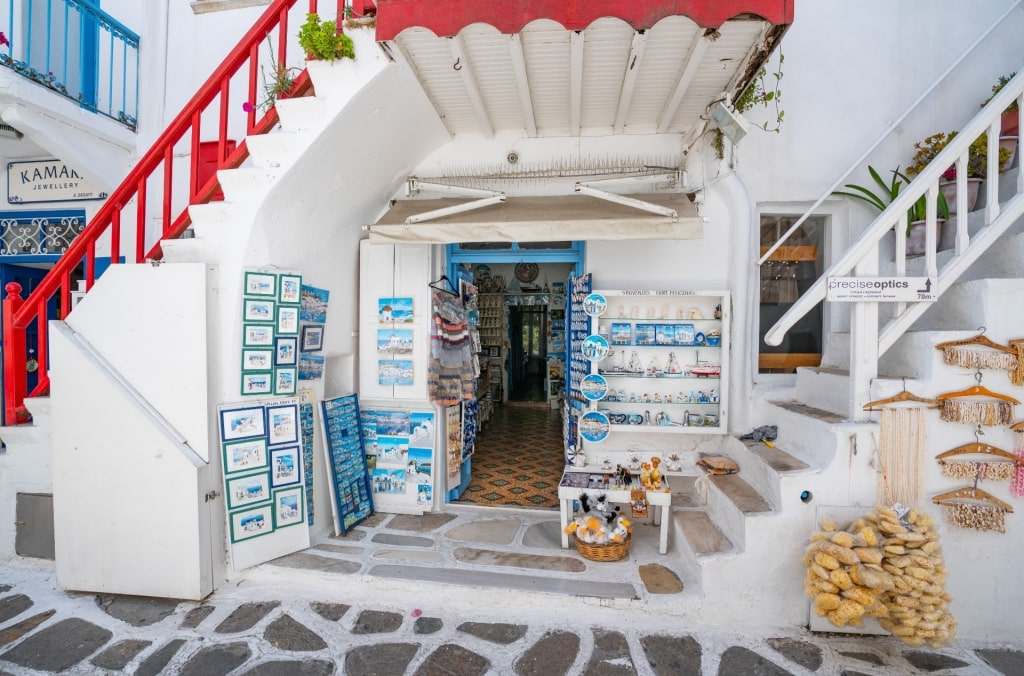
Old Town Mykonos
Shopping is one of the best things to do in Mykonos, and the streets of Mykonos Old Town are lined with everything from big-name designer brands such as Louis Vuitton, Gucci, and Dior, to local names including Faye Chatzi and ChrisP.
Clothes aside, there are also gold- and silversmiths, as well as art galleries—check out Rarity—and shops selling more traditional trinkets.
Live Like a Local at Pagka Market
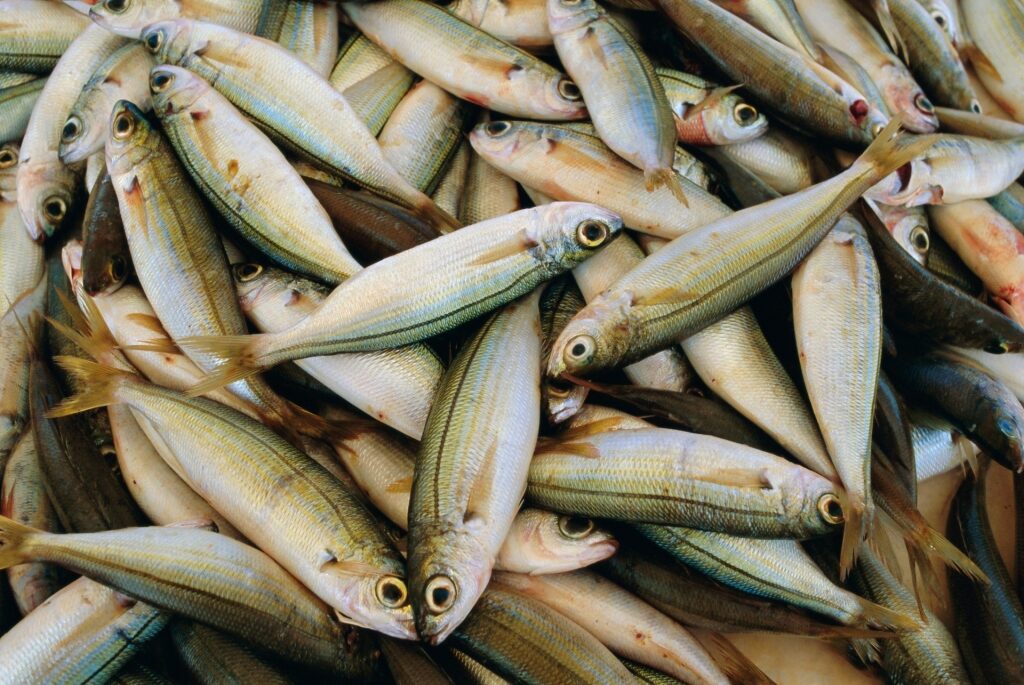
Fish
Mykonos is not all glitz and glamor—there are more prosaic things your typical Myconian gets up to, like regular food shopping. A great way to step into their shoes is to head over to Pagka market, held daily except Sundays at the Old Port.
It’s here that the traditional caique fishing boats come in and offer their landed catch for sale; straight from the boat onto a bench, pagka in Greek, to be snapped up for supper.
Pick Up Some Treats at Gioras Bakery
Set on Agiou Efthimiou Street in Mykonos Old Town, this traditional bakery is housed in a medieval building that the owners claim is the second oldest on the island.
What’s for sure is that it’s home to a more traditional wood-fired oven and the bakers produce a host of old-school treats: fresh choriatiko bread, amygdalota almond cookies, and various rusks.
Pick up something to eat and sip a thick, black Greek coffee from the on-site coffee shop for a quintessential Mykonos experience.
Sample Local Beer
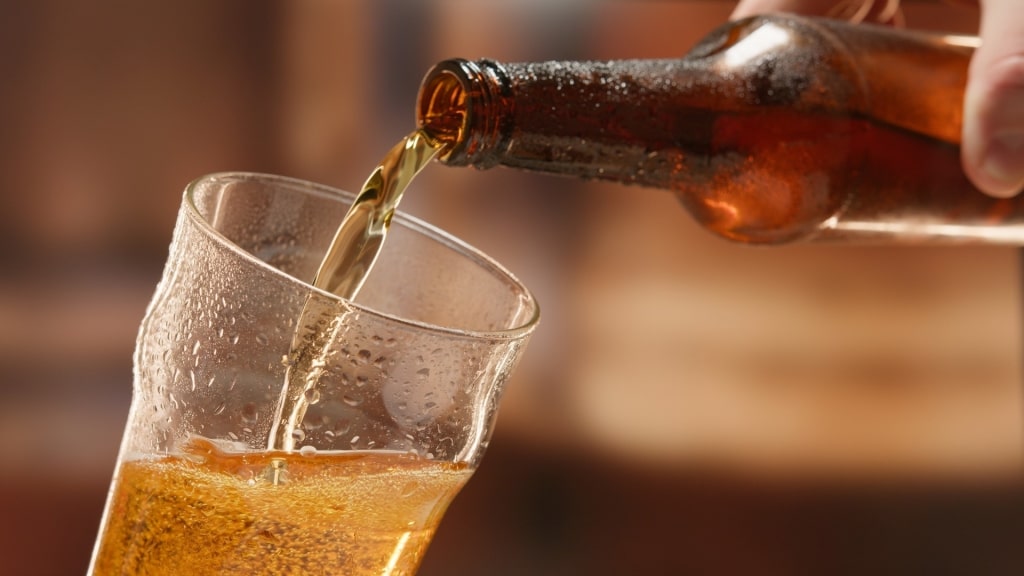
Beer
In a former bowling alley just outside Old Town Mykonos lies the Mykonos Brewery Company. This local microbrewery and tap room is where artisanal craft beers use desalinated water and Myconian hops to provide their Mikònu beers with a unique flavor.
You can tour the factory, learn how they are made, and sample them in the onsite bar, but don’t worry if you can’t make it to the brewery itself; most of the bars around town offer Mikònu as a standard.
Visit Agios Nikolakis Church
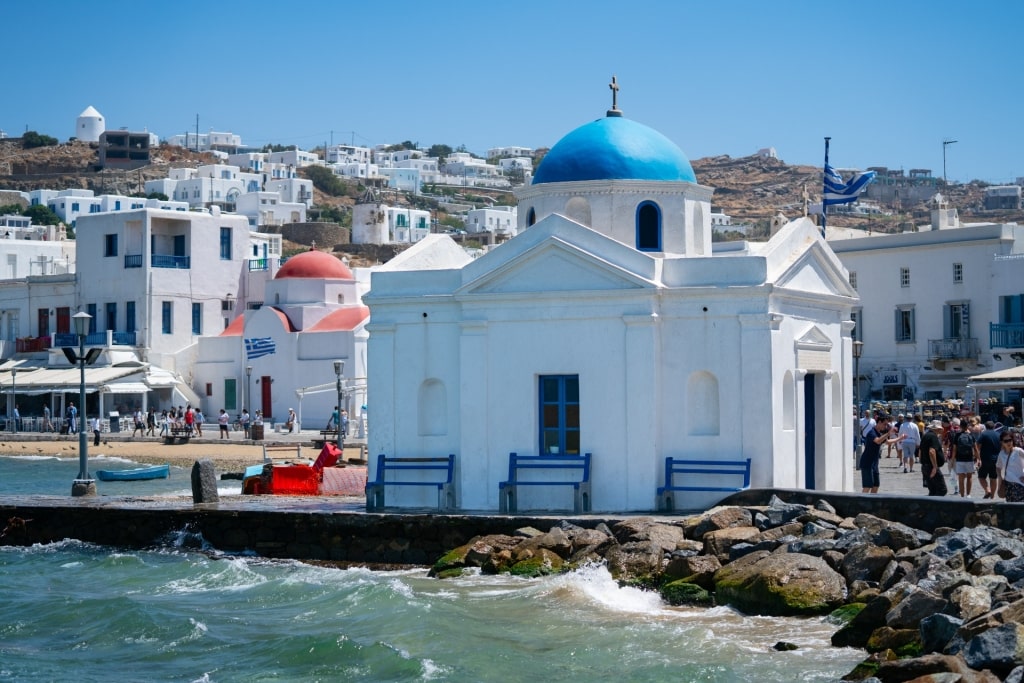
Agios Nikolakis Church
Sitting right on the quayside in Mykonos Old Town, Agios Nikolakis is a small chapel dedicated to protecting all who sail, in particular the island’s fishing fleet.
Inside it’s quite minimal and decorated with the usual gilt-edged, Byzantine-style Greek Orthodox icons. Candles, to be lit in honor or memory of loved ones, can be purchased with a donation of a euro or two into an honesty box.
Restaurants
M-Eating
The best Greek food relies on simple, fresh flavors from the best natural ingredients but at times it seems as though it’s hard to distinguish one traditional taverna from another.
That’s changed though over the years with chefs increasingly finding more ways to differentiate and deconstruct from the traditional. A great example is M-Eating, a high-end Old Town restaurant headed up by local chef Panagiotis Menardos.
Bagatelle Mykonos
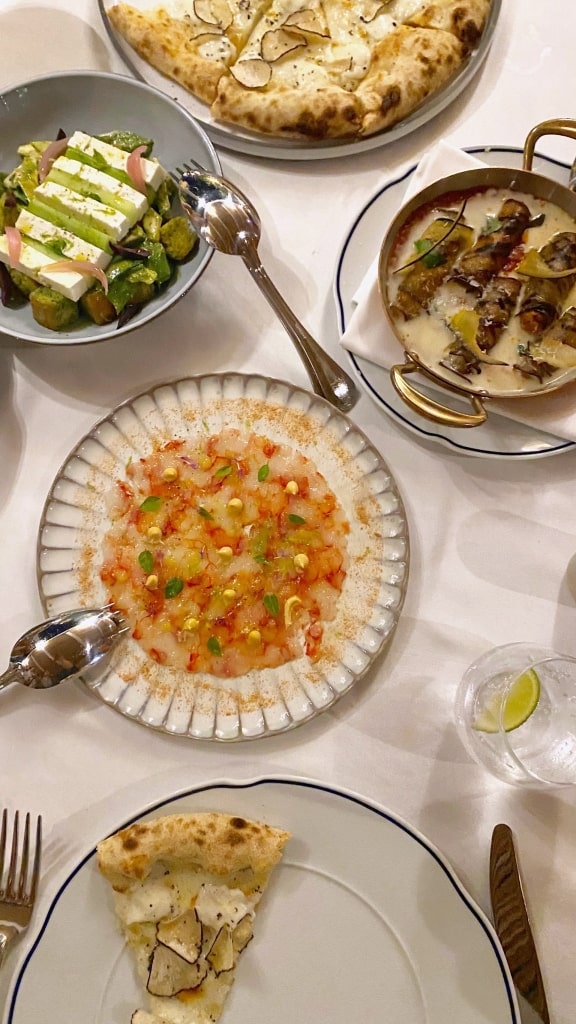
Bagatelle Mykonos
To the southern end of Mykonos Old Town, French restaurant Bagatelle is part of the wider Sunset Plaza complex that also includes the Sunset Lounge, a chic cocktail terrace, and Ita, which offers Mexican-Peruvian food.
At Bagatelle, Chef Rocco Seminara effortlessly blends French classics with Greek and other Mediterranean influences.
Maerio
A traditional twist on a Greek taverna comes at this hidden-away restaurant on Kalogera Street in the Old Town. Recipes to the dishes served here hark back to older, more simple times—and the techniques and ingredients used have been passed down over the generations to the two brothers who now own the restaurant.
Nōema
Another Chora classic, Nōema offers a different take on modern Greek cuisine using traditional methods and recipes at its heart. Fish are fermented in brine or cured in sea salt, meat is slow-cooked in clay pots, and cocktails are made with prickly pear liqueur. There’s also a hip tequila bar with DJs and live music.
Baboulas
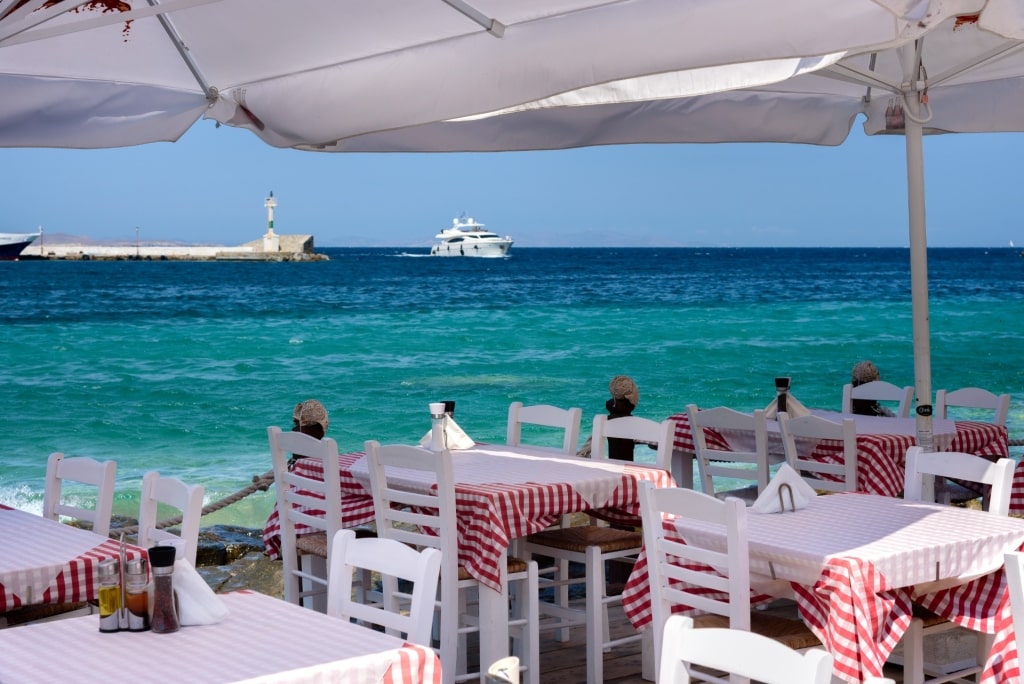
Baboulas Photo by Mustang Joe on Flickr, licensed under CC0 1.0
Less high-end but still big on flavors, Baboulas is a traditional ouzeri—a restaurant offering meze, usually mainly fish themed, and the local fire water spirit, ouzo.
Baboulas was a former fisherman and personally selects fish fresh from the daily market, with dishes prepared by his wife Petroula. They include zucchini fritters, octopus salad, prawn linguini, and catch of the day, simply grilled to perfection.
Travel Tips
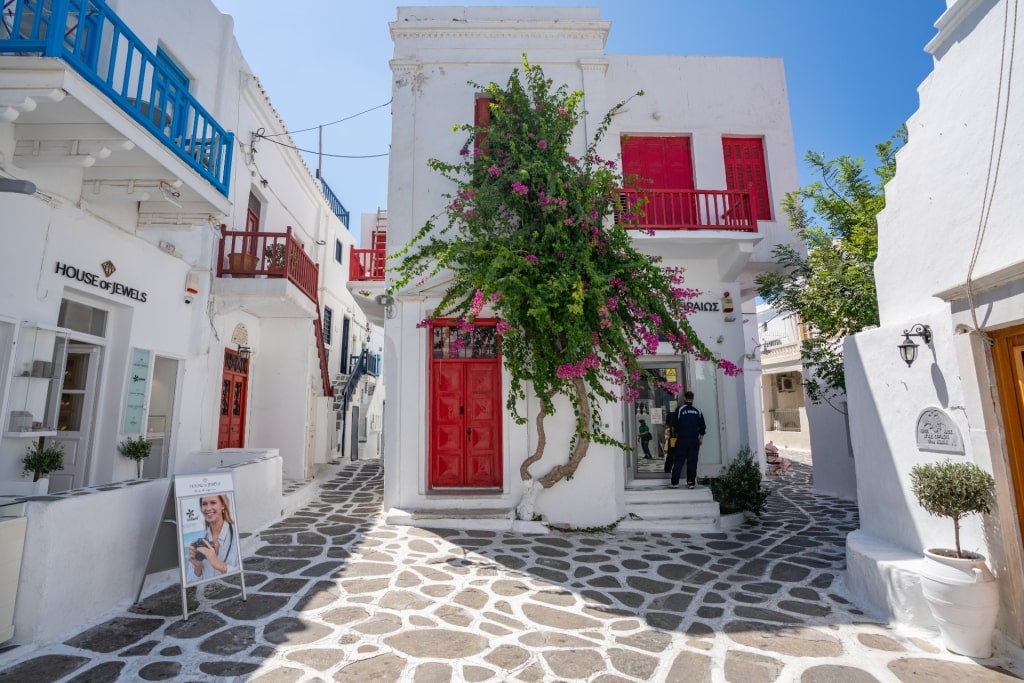
Matogianni Street
This shining Aegean jewel proudly wears its crown as one of Greece’s busiest, most liberally minded, and boldest islands. With most of life here coalescing around Mykonos Old Town, it can be on the hectic side, especially in August when most Greeks take their annual vacation.
Early spring and fall are lovely times to visit if you’re looking to escape the crowds, but do be aware that April sees the island starting its summer season and there’s no guarantee that everything will be open. Likewise, in September, the Aegean’s Meltemi winds tend to kick in; the Cyclades islands are known for their strong winds.
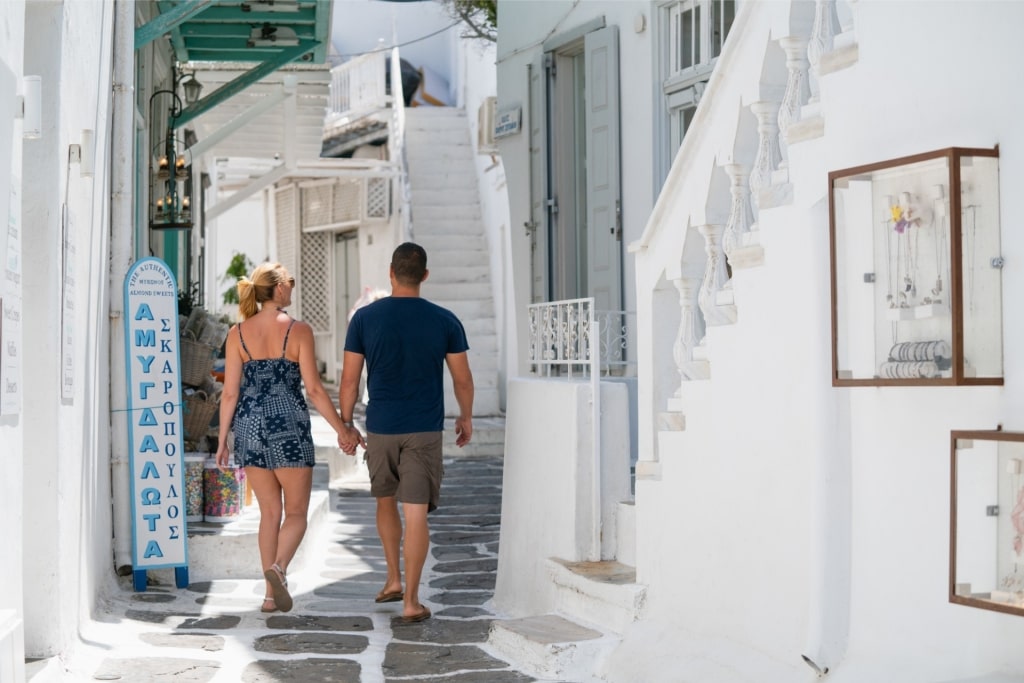
Matogianni Street
The dress code around the island is casual but chic. Think tank tops, tees, shorts, floaty dresses, and sandals—but pack your best clothes, and if it’s designer wear, even better. Walking around Mykonos Town from the afternoon onwards can be like a fashion parade. Don’t be under-dressed for it.
Do remember though, if visiting a religious or ancient site, covering shoulders and knees shows appropriate respect—and this goes for men and women.
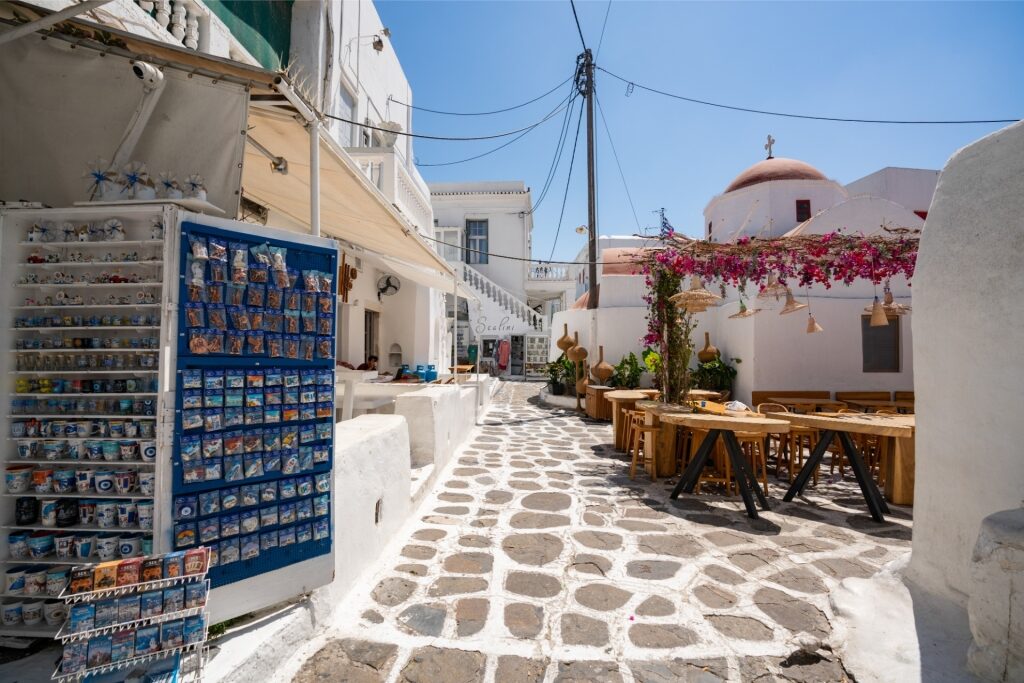
Matogianni Street
Aside from Chora’s designer shops, there are lots of things that can be bought that don’t cost the earth. Souvenir shops are plentiful, and the island is famed for jewelry and ceramics, with windmill motifs in typically Aegean blue and white very popular. Look out, too, for locally made leather sandals.
Local produce is of a high quality. Olive oil, olives, wine, honey, and pistachio nuts, the latter two combining well in baklava, are great edible “souvenirs” worth considering.
Read: 7 Days in Greece
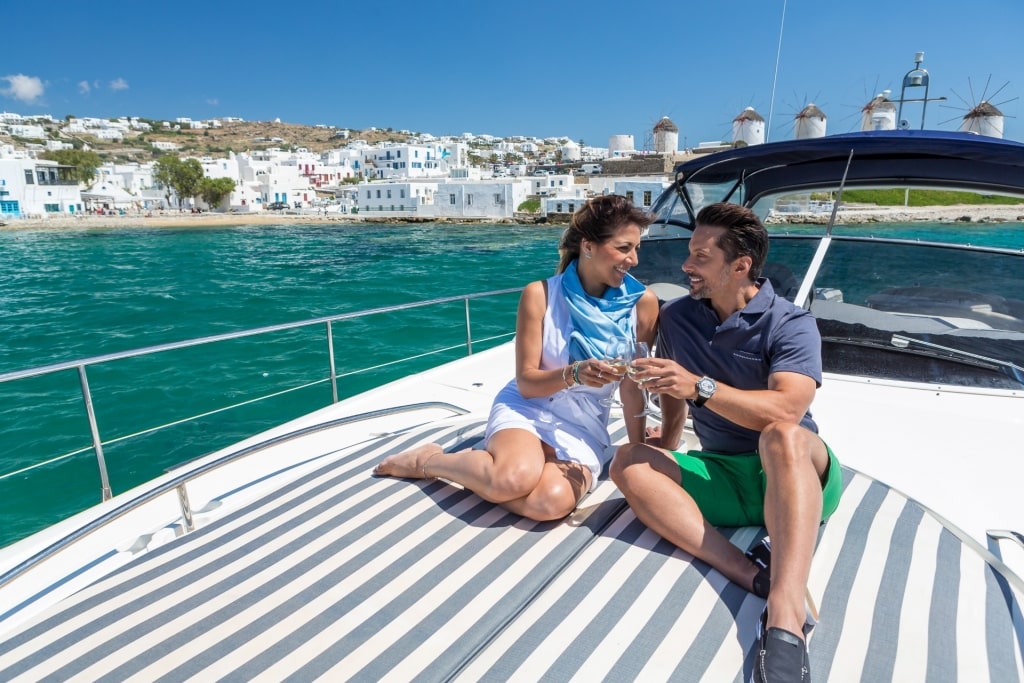
Mykonos
Discover the magic of the old town on one of Celebrity’s cruises to Mykonos. Browse itineraries on our website and book your Greek vacation today.
